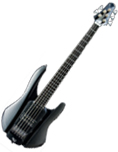RKS SymBass 5-String Bass


The SymBass used a neck-through design unlike most neck-through basses, which glue wings onto the neck slab to create a unified, standard shape body. Instead, the SymBass neck is part of a large, sculpted piece of ash that's wide enough at the butt end to hold both the string-through bridge and a humbucker pickup. If it weren't for the big, old-fashioned headstock, the neck section could pass for a Steinberger clone. Except, of course, that the neckpiece is glued to a guitar-shaped body that has been routed out to leave a gap of a halfinch or more between the neck and the two wings. With its smooth Satin Black fi nish, that part of the bass reminded me of an SR71 spy plane model I had as a kid. Still, it wasn't quite a jet, and it wasn't quite a Steinberger. Then, at rehearsal, it hit me. Holding the bass upside down in front of me, I turned to the guitarist and said, in my best basso profundo, "Luke, I am your father." Darth Bass, at your service.
IF YOU BUILD IT, THEY WILL COME RKS is an industrial design firm that wound up in the musical instrument business almost by accident. Ravi K. Sawhney, the Canadian-born head of the firm, was taking guitar lessons and wanted a better stand than what the market then offered. So he went to one of his designers with the idea of building the perfect stand, and before long, his team was working on creating the perfect guitar to go with it. Because they weren't traditional luthiers, the RKS team was as unfettered by tradition as Leo Fender when he put together the original P-Bass. Hence the gap between the neck through core and the rest of the body, a concept RKS calls Open Architecture Resonance (OAR), which focuses and refines the neck through sound.
Then there's the Groove Knob feature, which takes the volume and tone controls off the face of the instrument and builds them into the side of the neck section, down in the lower gap. It's a brilliant idea, placing the controls closer to your picking hand while simultaneously keeping them out of the way. At the same time, RKS wasn't trying to reinvent the wheel. Their basses feel traditional even if they don't look that way, and make good use of existing technology, such as the Buzz Feiten tuning system and Basslines pickups. All their basses are five-strings, with a maple core, swamp ash body, and ebony fretboard. There are essentially two models: the SymBass, with its symmetrical body design (think Gibson SG with significantly longer horns); and the ABass, with an asymmetrical body (imagine a very stylized P-Bass shape), and they do come in colors other than black. Despite its radical looks, the SymBass has a comfortably traditional feel. The 34"-scale neck is wide enough to facilitate generous string spacing, but flat enough to feel thin all the way up to the 24th fret. The gap provided by the OAR structure provides a natural thumb rest, and although it took a while to remember that the volume knob was in front of the humbucker and not behind it, manipulating the controls was a breeze once I got the hang of it.
But the true test of any bass design isn't how it looks or feels, but how it sounds-and that's where RKS really shines. For starters, OAR really works. In addition to producing tremendous sustain and punch, the SymBass offers an astonishing consistency of tone, delivering a tight, clear sound from the low end of the B string to the upper end of the G. Even better, the Basslines humbucker gives the SymBass a classic sound, one that starts somewhere between the round warmth of a vintage P-Bass and the midrange bite of a Sting- Ray, then blossoms into a J-Bass growl when pushed. And even though it lacks the fortified muscle of active circuitry, the SymBass made it easy to be heard through a noisy mix, because the tone cut through without roaring.
THE BOTTOM LINE Despite its extreme aesthetic, the RKS won't appeal to bassists who hunger for sonic extremes; clanky brights and dub-like subfrequencies simply aren't on the menu. But for pretty much anything else, its comfortable feel, innovative design features, and expressive, malleable tone makes it the sort of bass you can rely on regardless of the gig. The Force may not be with you, but the groove sure will be.
Get The Pick Newsletter
All the latest guitar news, interviews, lessons, reviews, deals and more, direct to your inbox!
“An esoteric boutique vibe, superb ergonomics and a powerful, unique preamp – Tobias is back”: Tobias Growler IV review
“Affordable versions of the three best basses I've ever held in my hands”: Sterling by Music Man completes its trilogy of Joe Dart signature models with a trio of made-to-order basses that cost less than $500


![[from left] George Harrison with his Gretsch Country Gentleman, Norman Harris of Norman's Rare Guitars holds a gold-top Les Paul, John Fogerty with his legendary 1969 Rickenbacker](https://cdn.mos.cms.futurecdn.net/TuH3nuhn9etqjdn5sy4ntW.jpg)







